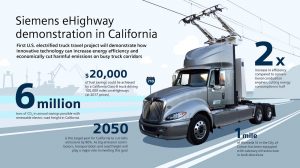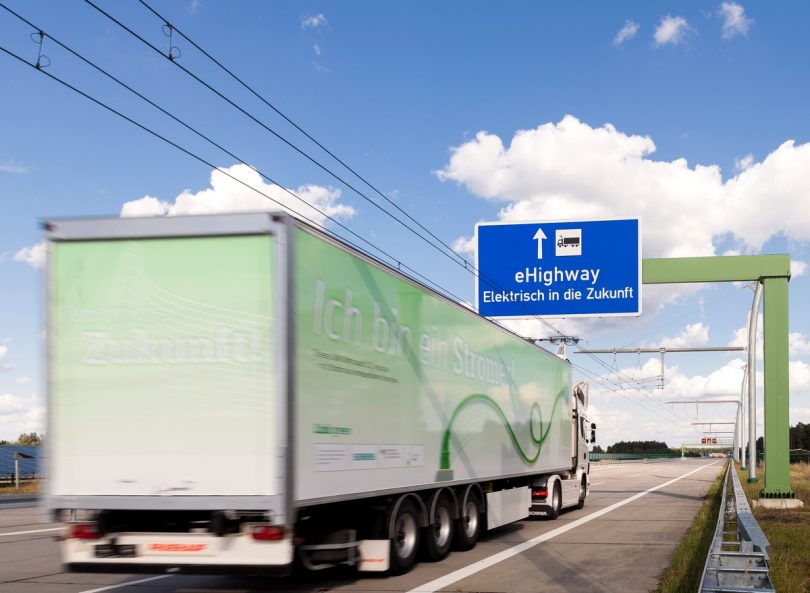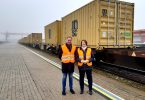Siemens and the “South Coast Air Quality Management District (SCAQMD)” are running a one-mile, zero-emission eHighway system demonstration in the Californian city of Carson, U.S., near the ports of Los Angeles and Long Beach. Three trucks hauling freight are running along the stretch of highway which uses Siemens technology to electrify select highway lanes via an overhead catenary system. This catenary system supplies the trucks with electric power, similar to how modern-day trolleys or streetcars are powered on many city streets. The system also allows for truck operation outside of the electrified sections of infrastructure.
Heavy-duty trucks are the number one source of smog-forming emissions in Southern California. Developing a zero or near-zero goods movement system in the ports will reduce smog-forming, toxic and greenhouse gas emissions in communities around the ports, which are some of the most heavily impacted by air pollution.
“This project will help us evaluate the feasibility of a zero-emission cargo movement system using overhead catenary wires,” said Wayne Nastri, SCAQMD’s executive officer. “This demonstration could lead to the deployment of eHighway systems that will reduce pollution and benefit public health for residents living near the ports.”
“Every day, Americans rely on the goods and services that are carried by freight. This mode of transportation is predicted to double global CO2 emissions by 2050”, said Roland Edel, Chief Technology Officer of Siemens Mobility Division, “our eHighway technology has the capacity to double efficiency in comparison to regular diesel-powered trucks. This in turn cuts energy consumption in two and reduces local air pollution around America’s largest harbors.”
A battery-electric truck, a natural gas-augmented electric truck and a diesel-hybrid truck are now driving on a one-mile catenary system on the north- and south-bound lanes of South Alameda Street from East Lomita Boulevard to the Dominguez Channel in Carson. The system is expected to lower fossil fuel consumption, reduce truck operating costs, substantially reduce smog-forming, toxic and CO2 emissions, and help accommodate the growing reliance on freight transportation.
The aim of this specific project is to demonstrate the eHighway system applied in truck operation on public roads in the U.S. and to further prepare applications for larger scale initiatives in the future.

Siemens and the “South Coast Air Quality Management District (SCAQMD)” are running a one-mile, zero-emission eHighway demonstration in the Californian city of Carson, U.S., near the ports of Los Angeles and Long Beach.
The demonstration system, similar to trolley systems or streetcars, features an overhead contact line that makes power available to trucks along the road and an active pantograph located on top of the eHighway trucks that transfers energy from the overhead lines to the truck’s electric motors. The pantograph can connect and disconnect automatically with the contact line via a sensor system while the trucks are moving giving them the same flexibility as conventional diesel trucks. This allows the trucks to easily switch lanes or pass other vehicles without being permanently fixed to the overhead systems like a streetcar.
To further ensure the same flexibility as conventional trucks, eHighway vehicles use an electric hybrid drive system, which can be powered either by diesel, compressed natural gas (CNG), battery or other on-board energy sources, when driving outside of the catenary lines.
In June 2016, Siemens launched the world’s first eHighway system on public roads in Sweden. It is running on a two-kilometer section of the E16 highway north of Stockholm through 2018. Two bio-diesel-hybrid vehicles are being used for the project.
In addition, three field trials of the eHighway technology on German highways are planned to start operation in 2019.
The USD 13.5 million project in California is funded by USD 2.5 million from SCAQMD, as well as USD 4 million from a settlement with China Shipping, USD 3 million from the California Energy Commission, USD 2 million from the Port of Long Beach and USD 2 million from LA Metro. In addition, Siemens provided a USD 1.3 million in-kind contribution. SCAQMD is providing an additional USD 2.1 million and the US EPA is providing USD 500K for the TransPower contract.
Under a separate contract with SCAQMD, the natural gas hybrid and electric trucks have been developed by Escondido-based TransPower and the diesel hybrid was developed by Volvo’s subsidiary, Mack Trucks.
More about it:
– Video: Siemens eHighway Animation Port Application
– Video: e-Highway2050 project in the European Union
The e-Highway2050 project is supported by the EU Seventh Framework Programme and is aimed at developing a methodology to support the planning of the Pan-European Transmission Network, focusing on 2020 to 2050, to ensure the reliable delivery of renewable electricity and pan-European market integration. The project will result in a modular development plan for possible electricity high- ways and options for a complete pan-European grid architecture, based on various future power system scenarios.





